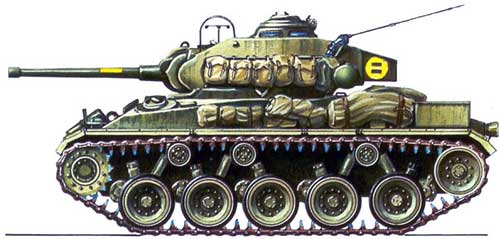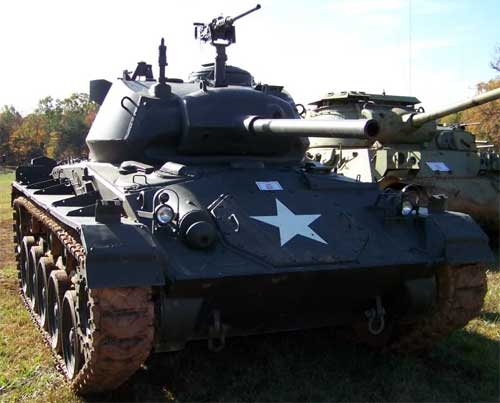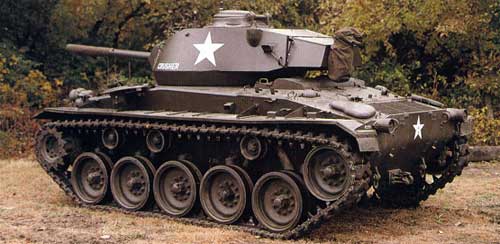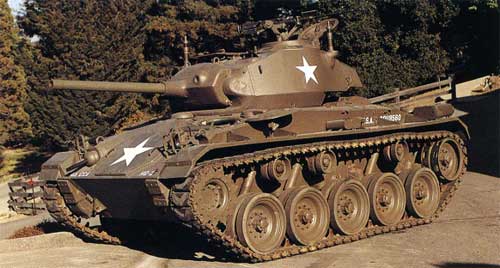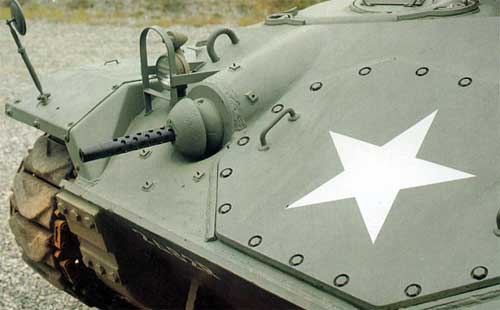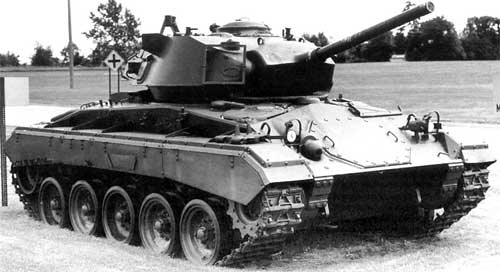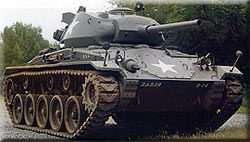
Light tank M24 "Chaffee"
Content
Light tank M24 "Chaffee"Light tank M24, Chaffee.
To facilitate repairs in the field, the sheets of the aft part of the hull roof are removable, and a large hatch is made in the upper front sheet. In the chassis, 5 road wheels of medium diameter on board and an individual torsion bar suspension are used. A 75 mm modified aircraft gun and a 7,62 mm machine gun coaxial with it were installed in the turret. Another 7,62 mm machine gun was mounted in a ball joint in the frontal hull plate. A 12,7 mm anti-aircraft machine gun was mounted on the roof of the tower. To improve the accuracy of shooting from a cannon, a Westinghouse-type gyroscopic stabilizer was installed. Two radio stations and a tank intercom were used as means of communication. M24 tanks were used at the final stage of the Second World War, and in the post-war period were in service with many countries of the world. Compared to the light tank M5, which replaced it, the M24 meant a significant step forward, the M24 far surpassed all light vehicles of the Second World War in terms of armor protection and firepower, as for mobility, the new tank had no less maneuverability than its predecessor M5. Its 75-mm cannon was almost as good as the Sherman gun in terms of its characteristics and surpassed the armament of most medium tanks of the 1939 model in terms of firepower. Serious changes made to the design of the hull and the shape of the turret helped to eliminate vulnerabilities, reduce the height of the tank and give the armor rational tilt angles. When designing the Chaffee, special attention was paid to providing easy access to the main components and assemblies.
Design work for the installation of a 75-mm gun on a light tank began almost simultaneously with the development of a medium tank armed with the same cannon. The 75-mm T17 self-propelled howitzer, created on the basis of the M1E3 combat vehicle, was the first step in this direction, and a little later, when the need arose for a light tank with the same firepower as the M4, the M8 self-propelled howitzer underwent a corresponding modification. Armed with a 75mm M3 cannon, this model received, albeit not quite officially, the designation M8A1.
It was based on the M5 chassis, capable of withstanding the loads arising from the firing of a 75-mm gun, but the M8A1 version was devoid of the basic qualities inherent in a tank. The requirements for the new vehicle assumed the preservation of the same power plant, which was equipped with the M5A1, an improvement in the chassis, a reduction in combat weight to 16,2 tons and the use of a booking thickness of at least 25,4 mm with pronounced angles of inclination. The big drawback of the M5A1 was the small volume of its turret, which made it impossible to install a 75 mm cannon. Then there was a proposal to build a light tank T21, but this machine, weighing 21,8 tons, turned out to be too heavy. Then the light tank T7 attracted the attention of the command of the tank forces. But this vehicle was developed by order of the British army for a 57-mm cannon, and when the Americans tried to mount a 75-mm gun on it, the weight of the resulting model increased so much that the T7 passed into the category of medium tanks.
The new modification was first standardized as an M7 medium tank armed with a 75 mm cannon, and then standardization was canceled due to logistical problems that inevitably arose due to the existence of two standard medium tanks. In October 1943, the Cadillac company, which was part of the General Motors Corporation, presented samples of a car that met the requirements put forward. The machine, designated T24, satisfied the requests of the command of the tank troops, which ordered 1000 units, without even waiting for the start of the tests. In addition, samples of the T24E1 modification with an engine from the M18 tank destroyer were ordered, but this project was soon abandoned.
The T24 tank was equipped with a 75 mm T13E1 gun with a TZZ recoil device and a 7,62 mm machine gun on a T90 frame. The cannon's quite acceptable weight is explained by the fact that it was developed on the basis of the M5 aircraft gun and its new designation M6 simply meant that it was intended to be mounted not on an aircraft, but on a tank. Like the T7, the twin Cadillac engines were skid mounted to facilitate maintenance. By the way, Cadillac was chosen for mass production of the T24 precisely because the T24 and M5A1 had the same power plant.
The T24 was equipped with a torsion bar suspension of the M18 tank destroyer. There is an opinion that this type of suspension was invented by German designers, in fact, an American patent for a torsion bar suspension was issued in December 1935 to W.E. Preston and J.M. Barnes (future general, head of the research service of the Department of Armaments until 1946 ). The undercarriage of the machine consisted of five rubberized road wheels with a diameter of 63,5 cm, a front drive wheel and a guide wheel (on board). The width of the tracks reached 40,6 cm. The T24 body was made of rolled steel. The maximum thickness of the frontal parts reached 63,5 mm. In other, less critical places, the armor was thinner - otherwise the tank would not fit into the light category. A large removable cover in an inclined front sheet provided access to the control system. The driver and his assistant had overlapping controls at their disposal.
In July 1944, the T24 was standardized under the designation M24 light tank and received the name "Chaffee" in the army. By June 1945, 4070 of these machines had already been built. Adhering to the concept of a light combat group, American designers developed a number of self-propelled artillery mounts on the basis of the M24 chassis, the most interesting of which was the T77 multi-barrel ZSU: a new turret with a six-barrel machine gun mount of 24-caliber was installed on the standard M12,7 chassis, which underwent minor modifications. mm. In some way, this machine became the prototype of the modern, also six-barreled, anti-aircraft system "Volcano".
After the war, "Chaffee" was in service with the armies of several countries and took part in the hostilities in Korea and Indochina. This tank successfully coped with the implementation of a wide variety of tasks and served as the basis for numerous experiments. So, for example, the tower of the French tank AMX-24 was installed on the M13 chassis; at the test site in Aberdeen, a modification of the M24 was tested with the suspension of a German 12-ton tractor with caterpillars for three-quarters of the chassis, however, when the prototype was moving off-road, the test results were not satisfactory; a 24-mm gun with automatic loading was installed on the M76 layout, but things did not go beyond this experiment; and, finally, the “anti-personnel” version of the T31 scattered fragmentation mines on both sides of the hull in order to prevent enemy infantry from getting close to the tank. In addition, two 12,7 mm machine guns were mounted on the commander's cupola, which significantly increased the firepower available to the tank commander. An assessment of the British experience of fighting in the Western Desert in 1942, when the 8th Army used the M3, showed that promising American tanks would need more powerful weapons. In an experimental order, instead of a howitzer, a 8-mm tank gun was installed on the M75 ACS. Fire tests showed the possibility of equipping the M5 with a 75 mm gun.
The first of two experimental models, designated T24, was presented to the military in October 1943, and it turned out to be so successful that ATC immediately approved an order for industry for 1000 vehicles, later increased to 5000. Cadillac and Massey-Harris took up production, jointly produced from March 1944 until the end of the war 4415 vehicles (including self-propelled guns on their chassis), displacing the M5 series vehicles from production. Performance characteristics
Pilot machines and other projects:The T24E1 was an experimental T24 powered by a Continental R-975 engine and later with an extended 75mm cannon with a muzzle brake. Since the M24 turned out to be quite successful with the Cadillac engine, no further work was carried out with this machine. |
 The M24 tank began to be produced in 1944. It was intended for use in reconnaissance units of infantry and armored divisions, as well as in airborne troops. Although the new vehicle used separate M3 and M5 units (for example, a gearbox and a fluid coupling), the M24 tank differs sharply from its predecessors in the shape of the hull and turret, armament power, and undercarriage design. The hull and turret are welded. The armor plates are approximately the same thickness as those of the M5 series, but are located at much greater angles of inclination to the vertical.
The M24 tank began to be produced in 1944. It was intended for use in reconnaissance units of infantry and armored divisions, as well as in airborne troops. Although the new vehicle used separate M3 and M5 units (for example, a gearbox and a fluid coupling), the M24 tank differs sharply from its predecessors in the shape of the hull and turret, armament power, and undercarriage design. The hull and turret are welded. The armor plates are approximately the same thickness as those of the M5 series, but are located at much greater angles of inclination to the vertical.